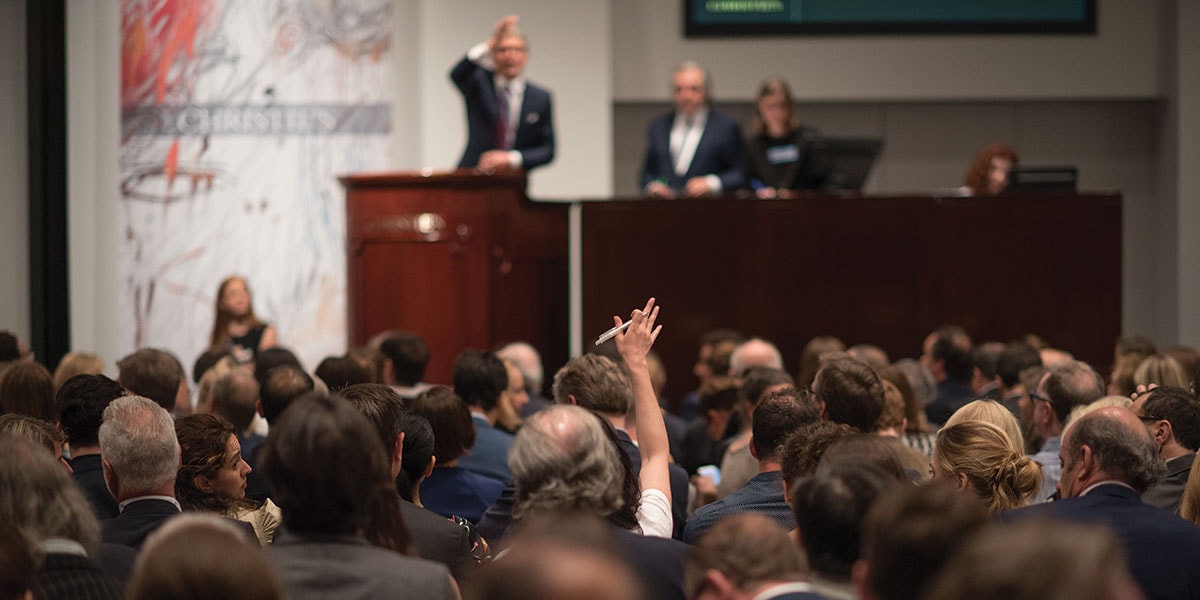Christie’s Post-War and Contemporary Art evening auction on 6 March in London saw another David Hockney’s double portrait achieving a record price. A painting of Henry Geldzahler and Christopher Scott from 1969 realised £37.6m, European record for a living artist. Andrea Mattiello, Byzantine and Contemporary Art Historian and Guest Lecturer at Christie’s Education looks at the secret behind the success of Hockney’s double portraits and their meaning in his oeuvre.
Q. The world record for living artists holds Hockney’s Portrait of an Artist (Pool with Two Figures) from 1972, which was sold at Christie’s New York in November 2018 for $90.3m. What drives the recent interest in Hockney’s double portraits?
During a career spanning more than six decades, David Hockney has developed multifaceted art productions and iconic images incapsulating complex visual research and challenging aesthetic values. Having experimented, mastered and innovated conventional painterly formats such as portraiture, landscape and photo-collage, Hockney has achieved a high degree of innovation, especially in the conception and execution of his double portraits during the 1960s and early 1970s. Highly regarded at the time of their production, they are now starting to be fully appreciated for their social, cultural and historical implications along with their masterly conception and execution. They help us to address why Hockney is a classic master of our time.
Q. Why is the portrait of Henry Geldzahler and Christopher Scott so monumental?
The portrait of Henry Geldzahler and Christopher Scott is significant because of the importance that both the artist and his sitters had in the context of New York’s dynamic art scene in the late 1960s. Geldzahler was an authority in the art world, so the choice of a double portrait, traditionally a motif of authority and legacy, reflected his status. At the same time, it represented a thinly veiled reference to his homosexuality. In this way, the double portrait revisited a pictorial tradition that was far from mainstream at the time, reviving it, but also made a significant contribution to Hockney’s complex visual research as it related to his progressive social agenda.
Q. What’s the meaning of double portraits in David Hockney’s oeuvre?
David Hockney has produced double portraits at different moments during his career. From his early years, training in the 1950s, David Hockney embarked on a journey to reinterpret figurative depiction, making recurrent use of double portraits. He used them as an opportunity to explore his identity, to examine gender roles, and to represent relationships, affection, and a sexuality that did not conform to the hetero-normative standards of the time. For example, his early same sex double portraits celebrated gay desire while also presenting images of companionships and domesticity, normalizing behaviours still ostracized in society at large.
Q. Can you tell us more about the history of double portraits?
The double portrait has a long and well-established tradition in the history of western art. It is routed in the Antique, Medieval and Renaissance practices of presenting authority, legitimacy and power. From an art historical longue durée perspective, double portraits were often the means by which sitters presented their lineage, family connections, and reciprocal affection. In the case of same sex sitters, double portraits often represented the transfer of a legacy from one generation to the next.
Andrea Mattiello leads a year-long course Certificate in Modern and Contemporary Art at Christie’s Education in London.

